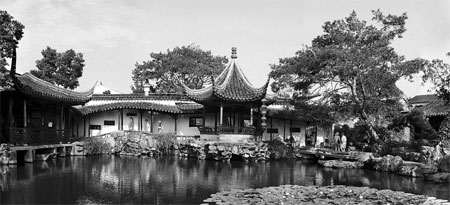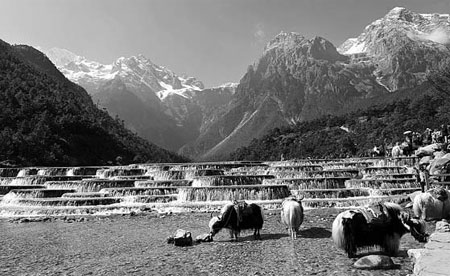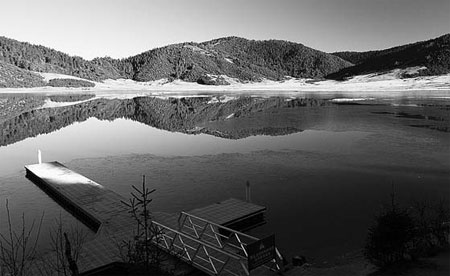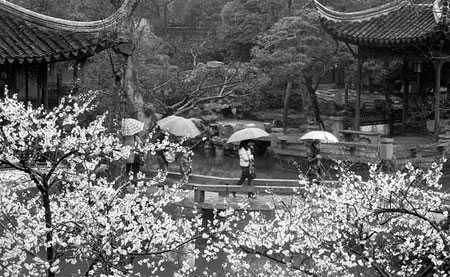In pursuit of the Eastern plant hunters
Following in the footsteps of the intrepid collectors who brought back many horticultural favorites, Matthew Biggs visits the beautiful Yunnan province of China.
The lifetime ambition of many gardeners is to visit China, described by the great plant collector Ernest "Chinese" Wilson as "the mother of gardens", to see garden plants in their native habitat. That desire was satisfied by a limited-edition trip I went on last year called Footsteps of the Planthunters, parts of which can be replicated by the tailor-made travel specialist Journeys of Distinction. Its focus was on Yunnan province, where the collectors George Forrest, Frank Kingdon-Ward and Joseph Rock risked their lives and tolerated unrelenting hardships in their search for unusual plants. We visited new gardens as well as old - for parks and gardens are changing in China, as the Western world exerts its influence on horticulture and environmental awareness.
Our journey began with three days in Shanghai followed by a three-hour flight to Kunming and the world-renowned Stone Forest, where we encountered Trachelospermum jasminoides, the "star jasmine" of conservatories, draped fragrantly over jagged limestone. From there we went by road to Lijiang, visiting its picturesque old city, and the nearby alpine yak meadow, a blaze of wild flowers on the lower slopes of Jade Dragon Snow Mountain. Finally we reached Shangri-La, in remote northern Yunnan, via the spectacular Tiger Leaping Gorge.
Even our initial three days in Shanghai connected us with the rural Chinese landscape. One outing was to the city of Suzhou, Jiangsu province, traveling at speeds of up to 249 kph on the smooth, silent bullet train. The nine classical gardens of Suzhou, designated a UNESCO World Heritage Site, are masterpieces of the genre, reflecting the importance of nature in their meticulous design.
Our first stop was the Humble Administrator's Garden, whose true meaning, our guide assured us, had been lost in translation. It was far too grand to convey the slightest vestige of humility, being a recreation of the scenery of the Lower Yangtze. Rising from the central lake and its islands, the tree-covered East and West Hills are crowned with pavilions. There are 48 in all, each evocatively named - the Hall of Distant Fragrance, the Listening to the Sound of Rain, the Snow-like Fragrant Prunus mume Pavilion. Spiritual and tranquil despite the crowds, each was a perfect example of proportion, perspective and the effective use of the borrowed landscape beyond.
Hidden among the city's narrow alleys, the Master of the Nets garden was altogether more human in scale. Once known as the Fisherman's Retreat, it is intimate, less grandiose and more in harmony with the human spirit - the type of garden one would gladly create at home.
In the centre of the garden, jasmine and wisteria flowers float serenely on a large reflecting pool, gently caressed by the passing breeze. The courtyards and alcoves are cameos of the garden. In one of these spaces, I came across three English visitors contemplating a group of plants. "My relative brought rhododendrons into Britain," one of the women said. Further inquiry revealed the relative's name - George Forrest. To my utter surprise, I had unexpectedly encountered the great-great-granddaughter of the man we were there to honour.

Even the city of Shanghai proved more steeped in horticulture than I had imagined. Despite the rapid expansion of the city, with its high-density, high-rise living, the authorities are aware of the importance of plants. Between the road and the pavement, dense plantings of trees and shrubs create green arteries channeling oxygen to its heart. There are plenty of green spaces, too, and the Shanghai Botanical Garden, espousing elements of both Chinese and Western garden style, is a remarkable place.
It is essential that you visit with an open mind. Expect something formal like the Royal Botanic Gardens at Kew in London, and you will be sorely disappointed. This is more of a public pleasure ground, a "park for the people", which schoolchildren have to visit twice a year for their education. Ignore the piped music from plastic stones, and focus instead on the garden's well-planned spaces, the diverse collection of plants in the tropical conservatory, and the vast area devoted to the Chinese national flower - the mountain, or tree peony - where groups of visitors jostle excitedly for space in an attempt to snap their floral "celebrities".
The overall effect is pleasing, enlightening and surprising, a display of real botanical excellence but with the atmosphere of a garden festival.
A few days later, having transferred to Lijiang, we left the comfort of our suites in the Ancient Town Crowne Plaza hotel and drove the 19 km to Jade Dragon Snow Mountain, whose snow-capped peaks and silvery grey slopes had been constantly admired from the hotel. After half an hour, the convoy of Land Cruisers suddenly diverted from the smooth, newly tarmacked road to bounce alarmingly down an undulating, rutted track lined with purple-flowered rhododendrons, kicking up dust clouds and springing the occupants from their seats. This was life as a modern-day plant hunter.
Our destination, Lijiang Alpine Botanical Garden, in the shadow of the mountain we so admired, is a biodiversity hotspot containing 10 percent of China's plant species. No wonder Forrest had been drawn to these high alpine meadows and camped on the lower slopes of Jade Dragon Snow Mountain.
The garden, a unique collaboration between Kunming Plant Research Institute and the Royal Botanic Garden in Edinburgh, recently celebrated its 10th anniversary. Said to be the highest botanical garden in the world, it is not your traditional Chinese garden of serene pools and bridges. Steep, roughly hewn stone steps lead sharply upward toward a new research station, where a cluster of greenhouses and flower-speckled terraces indicate the garden's presence. It is destined to become a major tourist destination, and we were thrilled to be the first group to visit. To our delight, the two large glasshouses were crammed with rare species. The garden is still a "work in progress", as a heavily laden mule confirmed, but it is well worth a visit even now. The number of plant species in the garden is expected to increase to 4,000 in the next 10 to 15 years.
Equally important for conservation is Pudacuo National Park in southwest Yunnan, a 50-minute drive from Zhongdian through villages where farmers plough with slowly plodding yaks. It is China's first national park to meet international standards and is one of the most biodiverse regions in the world. Its 1,295 square meters contain 20 percent of China's flowering plants, one-third of its mammals and birds, and 100 endangered species. In glorious sunshine, we walked around Shudu Lake on boardwalks protecting the precious habitat below. The moss-covered ground supported tiny primulas and giant conifers Abies forrestii and Pinus yunnanensis, their branches draped with silvery beards of lichen, while small birds chattered in the distance.
About 10 years ago, the council persuaded the Chinese government to change the name of Zhongdian to Shangri-La, the focus of James Hilton's 1933 fantasy novel Lost Horizon, in an effort to boost tourism. It seems as though Hilton's notion of paradise has touched not just the city but the national parks and gardens of China, increasing awareness of plants and the environment. The great plant hunters such as Forrest, who loved the country's flower-filled landscapes, would have approved.
|
The Master of the Nets Garden in Suzhou, Jiangsu province, is one of the finest gardens in China. It is recognized with other classical Suzhou gardens as a UNESCO World Heritage Site. Provided to China Daily |
|
The snow-covered and fog-enlaced Jade Dragon Snow Mountain resembles a jade dragon lying in the clouds. Wang Huabin for China Daily |
|
An autumn scene in Pudacuo National Park in Yunnan province. Provided to China Daily |
|
The Humble Administrator's Garden is the largest in Suzhou and is considered a great classical green space. Wang Jiankang For China Daily |
(China Daily 07/26/2014 page23)


















